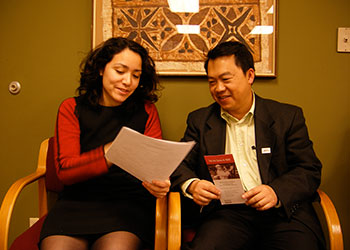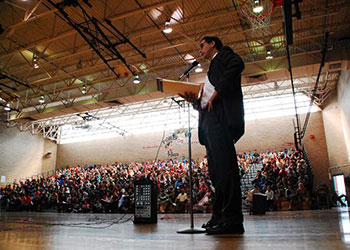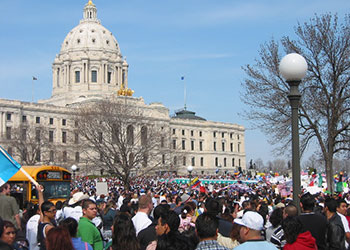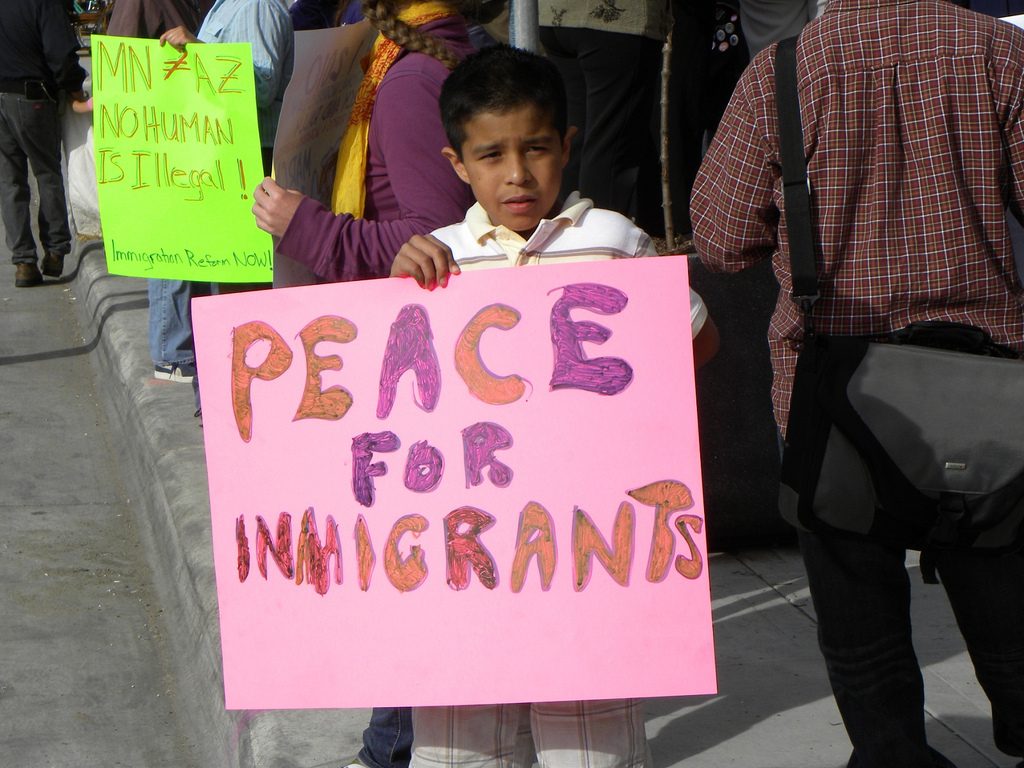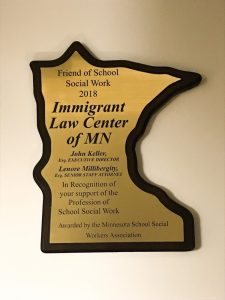Who organized or caused the caravan?
Bartolo Fuentes, an activist and former Honduran lawmaker, initially organized it. In an Oct. 4 Facebook post, he shared a graphic promoting a “Caminata del Migrante” (“Migrant March”). The graphic told migrants and protesters to gather on Oct. 12 at a bus station in San Pedro Sula, one of the most violent cities in the world. “We don’t leave because we want to, violence and poverty chases us out,” it said.
Trump has tweeted that the caravan is a result of “pathetic Immigration Laws” that Democrats refuse to change. But Trump-backed immigration bills that would toughen asylum standards and fund a border wall made no progress this year in the Senate or the House, despite both being controlled by Republicans. It’s unclear whether the measures backed by the White House would discourage migration from poverty- and violence-ridden countries such as Honduras, Guatemala and El Salvador.
Rep. Matt Gaetz (R-Fla.) tweeted an unverified video clip last week that showed a man distributing money to people with backpacks who appeared to be migrants. Gaetz suggested — citing no evidence — that billionaire philanthropist George Soros was behind the cash payout. Trump later tweeted the same video, but mentioned Democrats, not Soros.
Source: POLITICO
How did the caravan begin?
The caravan left San Pedro Sula, Honduras, on Oct. 12, assembled through a grass-roots social media campaign that started in early October. The campaign drew the attention of a Honduran news outlet, which focused on the organizers’ criticism of the Honduran president, and then spread to other outlets.
For Hondurans facing high unemployment, gang violence and a recent drought, the caravan’s appeal was clear. Within days, thousands joined the group. And as word spread through Central America, it drew people from Nicaragua, El Salvador and Guatemala.
The caravan offered safety on a route where many Central American migrants have disappeared or been kidnapped, and a way to circumvent the high price of hiring a smuggler to aid passage to the United States border.
Voices From the Caravan: Why These Honduran Migrants are Heading North
Source: The New York Times
Is this the biggest migratory caravan on record?
According to an estimate by the Los Angeles Times, the migrant caravan swelled to more than 7,000 people in recent days. Other estimates have placed it in the thousands, and the numbers appear to be in flux.
Caravans from Honduras have occurred since the late 1990s, but this appears to be the biggest, according to Andrew Selee, president of the nonpartisan Migration Policy Institute. The effort — partly a practical strategy for migrants to travel safely and partly a public protest — gained little attention in the U.S. until this spring, when Trump drew attention to a group of more than 1,000 migrants who left Honduras en route to the U.S.
Mass migration in itself — even from Central America — is nothing new. Hundreds of thousands of Salvadorans, Guatemalans, and Nicaraguans fled north to the U.S. and Mexico in the 1980s as those nations experienced brutal civil wars.
Source: POLITICO
Are border crossings at record levels?
Secretary of State Mike Pompeo said this week that a “record number of migrants” have arrived at the U.S.-Mexico border this year. That’s not true. Border Patrol arrested roughly 397,000 migrants in fiscal year 2018, a figure far lower than the arrest levels in the 1990s and early 2000s, when arrests frequently exceeded one million.
Arrests dropped to their lowest level in decades during Trump’s first year in office. During the past fiscal year they’ve increased, approximating levels during the Obama presidency. From fiscal 2009 to 2016, Border Patrol arrested a yearly average of roughly 413,000 people at the southwest border.
One statistic has reached historic levels: The number of family members arrested at the U.S.-Mexico border rose to roughly 16,658 in September, the most recorded in a single month since Border Patrol began compiling records of families in fiscal year 2012.
But a September 2017 report by the Homeland Security Department that examined available data found that the southwest border “is more difficult to illegally cross today than ever.”
Seth Stodder, a former DHS assistant secretary under President Barack Obama, said illegal immigration from Central America isn’t nearly as intense as what occurred with Cubans and Haitians fleeing in boats in the 1980s and 1990s. “It’s more like a dripping faucet than a rushing tide,” he said.
Source: POLITICO
What is life like for the migrants?
The journey is gruelling and poses a number of challenges for those who decide to join the caravan.
The hot weather means sunburn and dehydration are a constant risk, and some of the migrants have attempted to protect themselves with umbrellas and pieces of cardboard.
A number of people have fainted during the journey after walking for six consecutive days.
The migrants have been sleeping on the streets or in makeshift camps and there is a lack of clean water and sanitation.
Food is also in short supply, and local people have reportedly been providing the convoy with some food as it passes through.
At the border between Guatemala and Mexico, where migrants faced long waits as border officials checked their documents, there were clashes with police as tempers flared.
Some migrants threw stones and the police fired tear gas, leaving several people injured.
Source: BBC
Are there MS-13 members in the caravan? Are there Middle Easterners in the caravan?
President Donald Trump on Oct. 22 tweeted that “unknown Middle Easterners” were in the caravan, and late Tuesday afternoon a spokesman for the Department of Homeland Security tweeted that the agency “can confirm that there are individuals within the caravan who are gang members or have significant criminal histories.” Previously, DHS had declined to comment specifically on whether criminals were in the caravan. “Go into the middle of the caravans, take your cameras … you’re going to find MS-13,” Trump told reporters Monday night. But DHS did not state that the criminals in question belonged to MS-13.
But there’s no proof — something Trump acknowledged a day after making the claim. Reporters on Oct. 23 asked Trump for his evidence. Trump said he had “very good information” and that “there could very well be” Middle Easterners in the caravan.
Pressed for more information, Trump said, “There’s no proof of anything. But there could very well be.”
A Homeland Security Department spokeswoman said earlier this week that the U.S. Customs and Border Protection in fiscal year 2018 arrested more than 17,000 convicted criminals and 3,000 “special interest aliens” — a broad term that includes many countries around the world, including Bangladesh, Pakistan, Nigeria, and Somalia (DHS does not disclose the full list of countries).
Sources: Politifact, POLITICO
Will the administration cut off foreign aid? Can they?
Trump tweeted that because “Guatemala, Honduras and El Salvador were not able to do the job of stopping people from leaving their country and coming illegally to the U.S.,” the United States “will now begin cutting off, or substantially reducing, the massive foreign aid routinely given to them.”
It’s unclear where the administration will propose to make the cuts the President appears to be talking about, and CNN has reached out to the White House and the DHS for further information.
However, the Congressional Budget and Impoundment Control Act prohibits the President from withholding — or impounding — money appropriated by Congress.
New York Rep. Eliot Engel, the top Democrat on the House Committee on Foreign Affairs, said Monday that his office has reached out to the Government Accountability Office to ensure that the President does not violated the act.
“Fortunately, Congress — not the President — has the power of the purse, and my colleagues and I will not stand idly by as this Administration ignores congressional intent,” Engel said in a statement.
Trump has made the threat of cuts to foreign aid going to Latin American countries over migrant caravans several times over the last year.
Under the Trump administration, and with the approval of the Republican-controlled Congress, there have already been significant cuts to foreign aid to Guatemala, El Salvador and Honduras — the three countries he mentioned Monday — and the administration plans to continue making cuts in fiscal year 2019.
Source: CNN
What will a caravan member have to demonstrate to be admitted to the U.S. as an asylum seeker?
A person who enters the U.S. without authorization and seeks asylum must prove he or she has “credible fear” of persecution in his or her home country. The test is the first step in an asylum claim and could allow a migrant to remain in the U.S. pending a court date. Of the roughly 400 people who said they were part of the caravan this spring, more than 90 percent passed a credible fear screening, according to a DHS spokeswoman.
Source: POLITICO
How will the migrants be greeted at the border by the US government?
Trump has threatened to send the military to the border and shut it down before the migrants can enter. The president already ordered up to 4,000 National Guard troops to the border in the spring (roughly 2,100 are currently deployed), but there’s nothing they can do to discourage asylum seekers. In many cases, families surrender themselves at the border and claim asylum, which means more enforcement power won’t stop them.
When last spring’s caravan reached the San Ysidro port of entry near San Diego in late April, U.S. Customs and Border Protection “metered” the flow of people who could seek asylum. CBP officers permitted only small numbers of asylum seekers to enter for processing each day, leaving dozens of families waiting in Mexico for days.
A September report by the Homeland Security Department inspector general’s office found the practice of metering — which CBP contends prevents overcrowding and related hazards — could actually encourage more illegal crossings.
“Limiting the volume of asylum-seekers entering at ports of entry leads some aliens who would otherwise seek legal entry into the United States to cross the border illegally,” the report said.
Source: POLITICO
Will the President declare a national emergency over the caravan?
It’s unclear exactly what executive action, if any, the President will take following his tweet saying that he has “alerted Border Patrol and Military that this is a National (emergency).”
Previous administrations have ordered troops to the US southern border, and Trump issued a similar memorandum earlier this year ordering National Guard troops to be deployed to the US-Mexico border. The memo came around the same time another, smaller migrant caravan was moving toward the US through Central America.
Lieutenant Colonel Jamie Davis, a spokesman for the Defense Department, told CNN that “beyond the National Guard soldiers currently supporting the Department of Homeland Security on our southern border, in a Title 32, U.S. Code, section 502(f) duty status under the command and control of the respective State Governors, the Department of Defense has not been tasked to provide additional support at this time.”
The Department of Homeland Security, which oversees Customs and Border Protection, referred questions about the national emergency to the White House, which did not answer to several questions for comment.
Doris Meissner, a senior fellow at the Migration Policy Institute and the former commissioner of the Immigration and Naturalization Service, told CNN that the President’s use of the term national emergency, and his potential subsequent declaration, is “a subjective judgment.”
“It is certainly true that the numbers that have been reported in this group are larger than anything that we’ve seen before this from these countries concentrated in one group,” she said.
However, she added that the reaction is “disproportionate to what’s happening.”
“I’m not saying it’s not a genuine problem, but it’s not like this is organized insurrection, in the way that its been characterized,” she added.
Source: CNN

